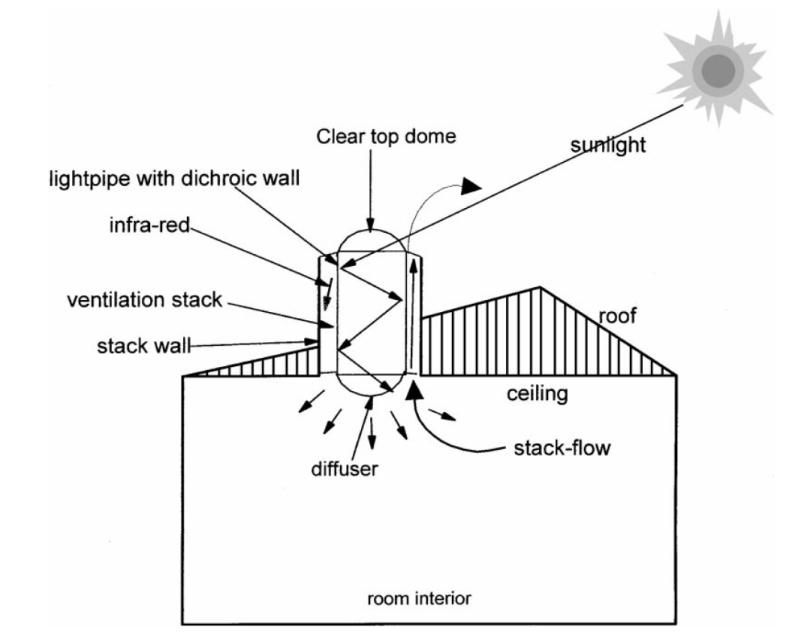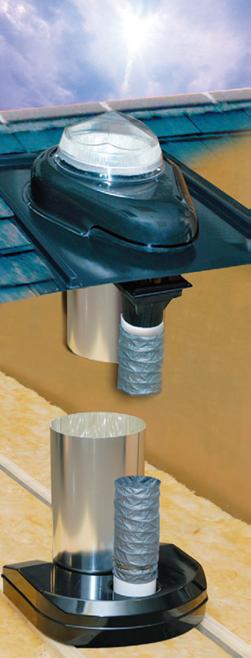Use of natural lighting and ventilation to deliver energy savings and commercial benefits
Submitting Institution
University of NottinghamUnit of Assessment
Architecture, Built Environment and PlanningSummary Impact Type
TechnologicalResearch Subject Area(s)
Engineering: Environmental Engineering, Materials Engineering, Interdisciplinary Engineering
Summary of the impact
University of Nottingham research into the use of natural lighting and
ventilation in building design has resulted in the development, marketing
and application of two new sister products (SunCatcher and Sola-Vent) by a
leading supplier of low-carbon, low-energy solutions. Since 2008, 745
installations of Sola-Vent units have been carried out by Monodraught Ltd.
Homes and commercial premises, both in the UK and overseas, have
benefitted from the low energy demands of the system. As well as
delivering economic benefits for the company, this work has had a positive
impact on building owners and occupiers and the wider environment.
Underpinning research
Given the need to cut energy demand, Dr Li Shao (Reader in Architectural
Environment Engineering, University of Nottingham 1993-2007) and his team
investigated the possibility of using natural lighting and ventilation as
a means to deliver low carbon solutions for lighting and ventilation,
especially in places that are away from the façade of the building and can
only be ventilated from above.
Light pipes were identified by the University of Nottingham (UoN) team as
having great potential to address this challenge. In the late 1990s Dr
Shao and Professor Riffat (Professor of Sustainable Energy, University of
Nottingham 1992 - present) published research into sunpipes and solar
chimneys, proposing the idea of integrating them into a single system. The
hypothesis was that if a light pipe is put in a larger duct, the annular
space surrounding the light pipe can facilitate natural ventilation. The
reflective liner inside a light pipe usually has a high reflectance for
visible light, but is less reflective in the infrared region of incoming
solar radiation. Absorption of this infrared radiation by the wall of a
light pipe will heat up the air in the annular space to cause a stack
effect (buoyancy), like a solar chimney. This ventilation can also be
driven by wind or by both wind and buoyancy. The proposed system would be
particularly suitable for the deep interiors of large buildings and
especially in schools, warehouses and other settings where security
considerations might limit the availability and effectiveness of
conventional forms of ventilation (e.g. windows).
 Figure 1: Illustration of Sola-Vent concept
Figure 1: Illustration of Sola-Vent concept
Together with six European partners, Shao and Riffat secured EU funding
to investigate the concept through the TRIPLESAVE project (G1). The
resulting work, carried out from February 1998 to July 2000, led to the
creation of an integrated light-vent pipe (LVP), with UoN responsible for
the conceptual design and testing of the prototype. UoN demonstrated that
the infrared part of the solar radiation could be absorbed by the surfaces
of the stack, transferring heat to the adjacent now more buoyant air, thus
facilitating natural ventilation extract while the visible light was
transmitted into the room below. The successful prototype was
commercialised by UK-based Monodraught Ltd, a recognised market leader in
low-carbon, low-energy products such as natural lighting, ventilation and
cooling systems; and was officially launched in 2002 as SunCatcher.
Building on this success, Shao and Riffat began to investigate the idea
of incorporating additional artificial lighting and ventilation, powered
by renewable resources, to produce a system that could be used in domestic
buildings. This strand of research, which began in 2004, had two key aims:
a) to use a photovoltaic-powered fan and spotlights, together with a
back-up battery and relevant control electronics, to allow for
controllable ventilation in hard-to-reach places where access to mains
power would require a complex installation [2.1]; and b) to facilitate
ventilation and lighting at night or in poor weather [2.2].
Key contributions to this work came from Riffat and Shao, who were
involved in the design and selection of the photovoltaic panel system
[2.3], and Dr Yuehong Su (Lecturer, 2005 - present), who developed an
experimental method to assess the ventilation rate and other performance
indicators through experimental and CFD studies [2.4].
Successful testing of a prototype system, developed with Monodraught and
using a DC fan duct (to allow active ventilation) aligned with a sunpipe,
led to subsequent commercialisation. Launched by Monodraught in 2005 as
Sola-Vent, the system won the Best Interior Product award at the 2006
Interbuild show, a major annual event for the UK construction industry.
Sola-Vent has received widespread uptake from 2008 onwards as described in
Section 4.
References to the research
References (Items marked with an asterisk indicate 3 most significant
papers):
2.1 *Oakley, G., Riffat, S.B. and Shao, L., 2000, Daylight Performance of
Lightpipes, Solar Energy, vol. 69, no. 2, pp89-98 DOI:
10.1016/S0038-092X(00)00049-9
2.2 *Shao, L., Riffat, S.B. and Gan, G., 1998, Heat Recovery with Low
Pressure Loss for Natural Ventilation, Energy and Buildings, vol.
28, no. 2, pp179-184 DOI: 10.1016/S0378-7788(98)00016-4
2.3 *Elmualim, A.A, Smith, S., Riffat, S.B. and Shao, L., 1999,
Evaluation of Dichroic Material for Enhancing Lightpipe/Natural
Ventilation and Daylighting in an Integrated System, Applied Energy,
vol. 62, no. 4, pp253-266 DOI: 10.1016/S0306-2619(99)00014-8
2.4 Su, Y.,Riffat, S.B., Lin, Y.L. and Khan, N., 2008, Experimental and
CFD Study of Ventilation Flow Rate of a Monodraught™ Windcatcher, Energy
and Buildings, vol. 40, no. 6, pp1110-1116
DOI:10.1016/j.enbuild.2007.10.001
Grants:
• TRIPLESAVE - An Integrated System for Daylighting, Natural Ventilation
and Solar Heating for Buildings (EU contract ref. JOR3-CT97-0172,
1998-2000), (PI Riffat)
• Heating/cooling/power generation system using PV concentration for
integration in high-rise buildings (May 2003-Feb 2005), funded through
Pilkington Energy Efficiency Trust (PEET), (PI Riffat)
Details of the impact
The technology developed as a result of the University of Nottingham's
research into the use of natural lighting and ventilation has been
employed in the design of low-carbon, low-energy buildings both in the UK
and overseas, delivering economic, environmental and societal benefits.
The technology developed by the University of Nottingham was licensed to
Monodraught Ltd and 745 units of Sola-Vent were installed between 2008 and
2012 in domestic and commercial buildings in the UK [4.1].
For example, the Newcastle-Under-Lyme College (NUL) installed 21
Sola-Vent units as part of its £60M investment in a new Construction
Skills and Technology Centre for its 3,000 A-Level students in 2008. This
contributed to the college's "excellent" BREEAM rating. Michael Giblin, a
spokesman for NUL's facilities management team said, "the Monodraught
natural ventilation strategy has been performing to expectations for three
years with no problems and no evidence of solar gains in any areas of the
college" and added that the "natural low maintenance, low cost, low energy
ventilation solution ticks all the boxes, ensuring that schools meet BB101
requirements for ventilation rates and CO2 levels" [4.2].
To indicate the energy saving credentials of the product, an energy
performance evaluation was carried out by UoN on a supermarket and an
annual lighting energy consumption saving of 22% was identified [4.1, 4.3,
4.4].
Riffat and his team have continued to work with Monodraught throughout
the impact period, producing a number of reports into the feasibility and
effectiveness of Sola-Vent and related products, so informing the firm's
marketing efforts.
In 2012 collaboration on a KTP project to transfer the University of
Nottingham's research expertise in building energy simulation to the
company resulted in Monodraught's adoption of dynamic thermal modelling
packages and daylighting simulation software in its quotation procedure
for specific high-value contracts. As a result, Monodraught now has
in-house dynamic thermal modelling capabilities and its own ventilation
testing system to determine the performance of existing and new products
[4.5, 4.6].
The software, named Performance Components was developed with Integrated
Environmental Solutions Ltd, and delivers optimised energy savings in
design. A team of 10 design engineers employed by Monodraught use this in
house to perform energy saving calculations. The software has made their
job easier and halved modelling time on complicated projects. [4.1]
This ongoing collaboration with the University of Nottingham has been
crucial to the company's growing success in the market. Sola-Vent products
have been installed in supermarkets, stores, schools and other buildings
and have earned Monodraught an increased share in the sector throughout
the impact period.
 Figure 2: Sola-Vent demonstration unit
Figure 2: Sola-Vent demonstration unit
Sources to corroborate the impact
4.1 Nick Hopper, Technical Director, Monodraught Ltd. Statement available
on request.
4.2 http://www.monodraught.com/news/5/monodraught-helps-awards-winning-newcastle-under-lyme-college-achieve-in-excellent-breeam-rating
4.3 Y Su, X Yu, L Zhang, M Karagianni, N Khan (2012) `Energy-saving
potential of Monodraught Sunpipes Installed in a Supermarket', Energy
Procedia, 14, 578-583
4.4 S Riffat et al (2010) `Assessment of Daylighting Design Using
Monodraught Sunpipes for a Supermarket', Proceedings of 9th
International Conference on Sustainable Energy Technologies,
Shanghai, China, August 24-27
4.5 http://www.monodraught.com/building-simulation/
4.6 http://www.monodraught.com/news/10/monodraught-and-ies-demystify-the-art-of-wind-tower-natural-ventilation-at-ecobuild/